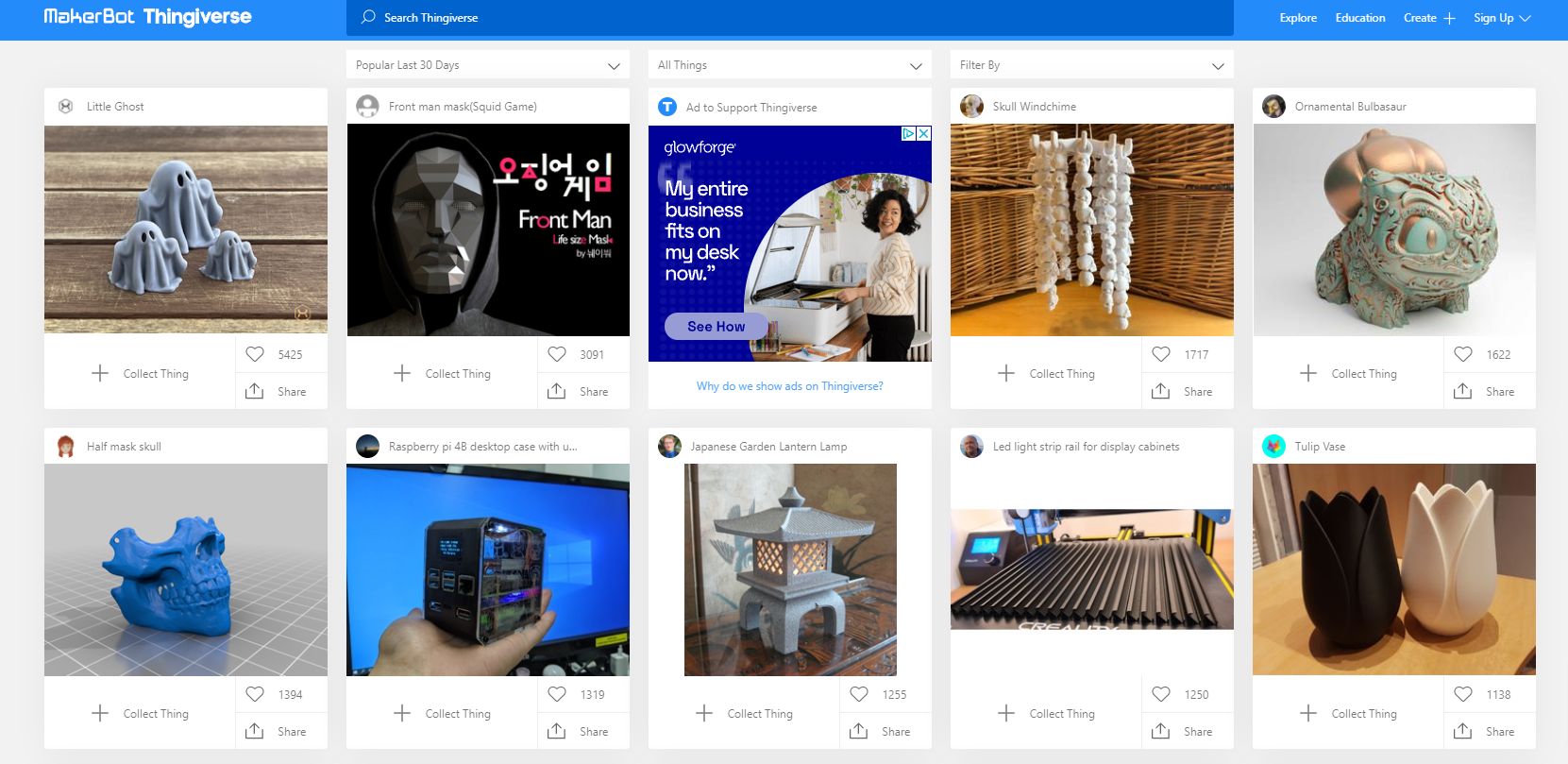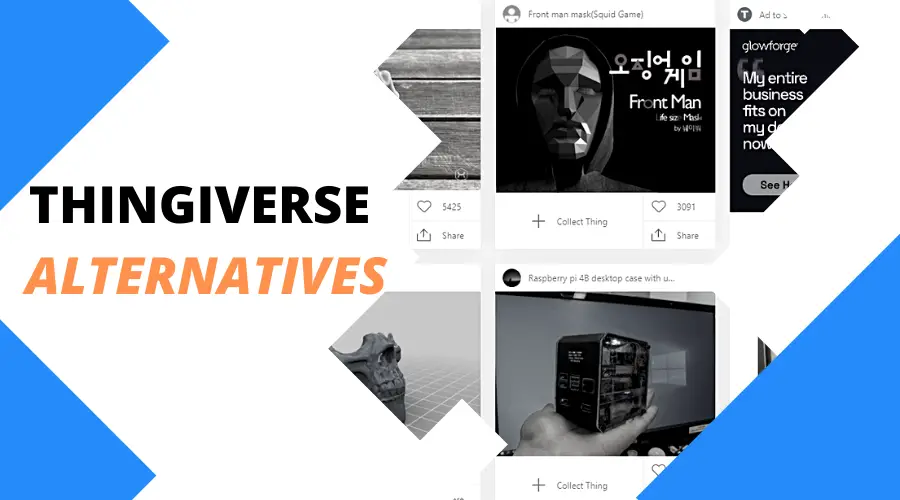Thingiverse is an open-source forum and platform for 3D designers to upload and share their projects and designs. The idea behind Thingiverse is to be a collective resource for all things related to 3D printing.
But is Thingiverse the best option for creators?
In this article, we’ll discuss the pros and cons of this platform and show you some Thingiverse alternatives.
From there, you can decide which site works best for your needs.
What is Thingiverse?

If you’re familiar with the hobby 3D printing community, you’ve probably heard of Makerbot. This company packages and sells DIY 3D printer kits, which are excellent for beginners to learn the craft.
Thingiverse began as a companion website to Makerbot’s kits, and it started back in 2008. Since then, however, it has expanded to encompass a vast array of 3D printed designs and pieces.
All creators, not just those using MakerBot kits, can upload their creations to the site. From there, other people can download, use, and augment any design they find.
To date, Thingiverse users have uploaded over 2.1 million designs to the platform. Since Thingiverse was one of the first open-source sharing platforms for the industry, it’s one of the most well-known and used.
Pros and Cons of Thingiverse
Just because Thingiverse is the largest and most notable 3D print sharing community doesn’t mean that it’s the best. Let’s break down some advantages and disadvantages of this platform.
Pro: Tons of Models and Designs
One primary benefit of Thingiverse’s expansive user base is that it has one of the largest collections of designs and prints. Virtually anything you can imagine is on the site, which can help spur your own creativity. The site acts as a 3D printing Pinterest, complete with pins of different designs that you can like and click on to find out more.
Con: Makerbot Enforces Design Restrictions
Although there are over 2.1 million products on Thingiverse, many more can’t be uploaded to the site. Because Makerbot is family-friendly, all of the designs have to be relatively PG or PG-13. So, if you’re looking for anything more risque or rated R, you’ll have to look elsewhere.
Pro: Simple and Efficient Layout
Another benefit of Thingiverse being the first 3D print repository is that it’s had plenty of time to overhaul and update its website. While the Pinterest-style layout may not be ideal for everyone, it’s easy to use for beginners and veterans alike. Everything is well organized, and you can find items that fit your interests pretty quickly.
Con: Pilfering of Ideas and Designs
Although Thingiverse is committed to combating piracy and fraud, there’s only so much that the site can do. Because it’s an open-source platform, there’s nothing stopping someone from repeating and selling your designs. Technically, this problem exists on all Thingiverse alternatives too, but it’s worth mentioning anyway.
Alternatives to Thingiverse
While you might get started on Thingiverse, it’s worth exploring other options too. Here are our top picks for Thingiverse alternatives that might offer more of what you want.
Repables
If you’re looking for an independently-run website that offers a better sense of community, Repables is an excellent option. Since this platform doesn’t represent any specific 3D printer brand, it isn’t focused on selling you products. Instead, you get pieces made by creators for creators. Many of these objects are mechanical parts that you can use to make other, more complicated equipment.
The user-centric focus of this website is kind of a double-edged sword. On the one hand, you can find some useful products and designs.
On the other hand, the site is not as streamlined or easy to use. F
or example, if you’re looking for a particular product type, you can search via keywords, but there are no groups or tabs like you’ll find on Thingiverse. If something doesn’t show up, you’ll have to scroll through tons of pages to find it.
Why It’s Good: 3D pieces and designs by creators for creators, with no corporate or business interests.
Things to Consider: The site layout is limited, and there is no quality control for each design. So, if there’s an issue, you have to take it up with the person who uploaded it directly.
YouMagine
This platform is a blend between Repables and Thingiverse. It’s more focused on users and community, and it has a website that’s much easier to navigate.
There are over 18,000 designs on YouMagine, and you can find ones written in CAD and 3D printing software. The quality control on YouMagine is excellent, and the site owners take significant measures to investigate theft and fraud. There is a strict shutdown policy in force so that you can feel a bit more comfortable uploading unique and proprietary designs.
The site is similar to Thingiverse since it uses the Pinterest-style layout. You can browse designs individually or by keywords. One helpful element is the addition of “Collections.” Users organize these sections, so they can be related to a wide array of topics or needs. Some examples of collections include:
- Dungeons and Dragons
- Mini Game Pieces
- Toys
- Animals
- Monsters
- Utility Parts
You can also create your own collections, which users can follow. This feature enables you to find fellow 3D printing enthusiasts who share your interests and passions.
Why It’s Good: Streamlined layout and decent quality control for designs. Over 18,000 design files are available, and you can create your own collections.
Things to Consider: This site is not as expansive as Thingiverse, and it can be hard to scroll through the various collections. Also, while you can email users, there’s not much else as far as community engagement tools.
Cults
Cults is closer to Thingiverse because it has a massive library of over 85,000 prints and designs. The site was founded in 2014, and it’s come a long way since then. It almost seems like many creators who disliked Thingiverse flocked to Cults once it went online.
The site is super easy to navigate as you can find designs for many unique collections. Examples include everything from art to fashion to architecture to tools. One feature that separates Cults from other platforms is the “Naughties” collection. You have to set up an account to view these pieces, as they’re meant for adult eyes only.
Like YouMagine, you can also find more segmented collections based on a single topic or theme. However, these groups are not user-made, so they’re more organized and easier to navigate.
Finally, Cults also has a community feature and a blog page. The blog provides valuable information and insight into 3D printing, which is helpful for newbies who want to get their feet wet. The community page has a newsfeed and shows you the top printers so that you can follow in their footsteps (or ask for advice).
Why It’s Good: Excellent website layout and tons of print models available. Cults also has a blog that can help creators of all skill levels get more from their machines.
Things to Consider: While Cults isn’t the “perfect” 3D print repository, there aren’t any significant drawbacks to pay attention to when signing up.
MyMiniFactory
One of the best ways to use a 3D printer is to make mini game pieces. MyMiniFactory is an excellent repository for tons of unique figurines for all kinds of games. Better yet, the site also has “tribes” focused on specific types of game pieces or genres. You can join a tribe to find other enthusiasts and creators, making it easier to find fellow players.
In 2018, MyMiniFactory opened a digital storefront on the website. This store allows users to sell their designs to make some money on the side. There are a few store categories, including Toys & Games, Jewelry, and Home & Garden. The pieces sold through the store are all high-quality, so you need to create some stunning print designs if you want to go that route.
While game pieces are the main draw of MyMiniFactory, you can find designs for different categories, including:
- Architecture
- Gadgets
- Props and Cosplay
- RC Cars
- Sports and Outdoors
There’s also an “Upcycling” section, which shows you how to incorporate various real-world elements into your designs. Some examples of upcycled products include a battery holder, wine glass holders, a light bulb planter, and more. If you’re serious about recycling and reducing waste, this collection is an excellent find.
Why It’s Good: You can make money on MyMiniFactory or just browse for different designs. The site also has unique collections like Upcycling.
Things to Consider: This site is mainly focused on toys and games and mini figurines. While they offer many other products, they’re more limited.
Pinshape
Our last Thingiverse alternative focuses more on the fun and community involvement connected with 3D printing. Not only can you find thousands of models and designs, but you can also read through blog posts, participate in contests, and engage with fellow printers.
As with some other sites, Pinshape organizes its collections into various themes, such as jewelry, toys & games, home & garden, and more.
Why It’s Good: If you want to get involved with other creators, this site is one of the most community-oriented.
Things to Consider: No significant drawbacks, but the repository is not as extensive as Thingiverse.
Overall, while Thingiverse is still the most extensive 3D print repository online, some high-quality alternatives exist. Knowing where to look ensures that you get more out of your 3D printer.

